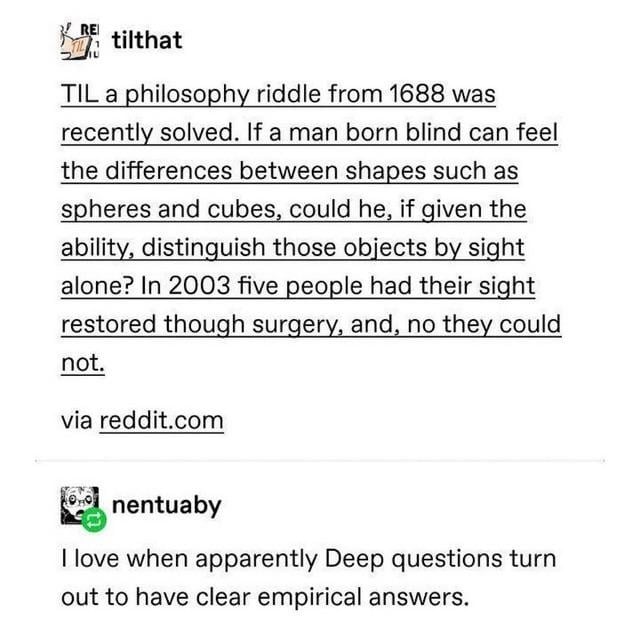this post was submitted on 21 Oct 2023
1046 points (98.5% liked)
Microblog Memes
6114 readers
3388 users here now
A place to share screenshots of Microblog posts, whether from Mastodon, tumblr, ~~Twitter~~ X, KBin, Threads or elsewhere.
Created as an evolution of White People Twitter and other tweet-capture subreddits.
Rules:
- Please put at least one word relevant to the post in the post title.
- Be nice.
- No advertising, brand promotion or guerilla marketing.
- Posters are encouraged to link to the toot or tweet etc in the description of posts.
Related communities:
founded 2 years ago
MODERATORS
you are viewing a single comment's thread
view the rest of the comments
view the rest of the comments

You're still assuming an ability to connect shapes to vision, even if what you're assuming is the most basic connection. Keep in mind these people had absolutely nothing to base their visual experiences on. I'm sure that given a few minutes to play with the objects they'd begin to map their visual inputs to mental models, but at first, it'll all look like abstract garbage
It's not that they don't have a sort of 3d model of a cube in their mind, it's that their 3d model of a cube includes absolutely nothing visual, which is virtually impossible for us to even imagine
I actually felt like my pointy bits method was entirely disconnected from experience. Yeah, they see abstract garbage, but they'll still see anomalies in this abstract garbage. And they were able to feel anomalies on the cube.
It does take some thinking to make a guess like that. And they may have still been completely overwhelmed with sight in general. And again, I don't know what the methodology in these tests looked like. But yeah, just summarizing it as "they could not" seems entirely unhelpful.
Could they tell that there are eight pointy bits? A cube only has between four and seven pointy bits, visually, although the seventh pointy bit would be pointing at them, and I'm not convinced that someone who's never seen before would be able to process what a corner looks like head on. If they could pick the items up to move them around, then they'd simply be able to tell by touch. Even if it was rotating on a turntable or something, they'd have no way to map the two dimensional image onto a three dimensional object in their mind. You can easily visualize how it looks to make one rotation of a cube, but if you've never visualized before, you'd have no way to translate what you're seeing to the model you have in your mind.
100% agree on wanting more than just "they could not," though
Also the whole bit with how eyes give a flattened 2D perspective from a distance of 3D objects they previously only has felt as 3D shapes directly in their hands
And there's two of them, giving slightly different images (but without the whole circuitry developed at a young age that manages to calculate distances from the slight differences between the two images... hell, they might even lack the circuitry that corrects for the images being upside down, at that!).
... So, they'll have to experience the world through its reflection in a biiig spoon.
Though it's virtually impossible to do, I like to imagine that their 3d object memories are analogous to data in a raw text file, representing every attribute of the object. However, they don't have the software (vision) to visually render it, or vice versa turn visual objects into "data points in files".
Since their brain is reading the file without visually rendering the object, the results of this experiment could be similar to us not recognizing a digital 3d object by reading the raw data without rendering it.
Or, on a musical note, similar to not recognizing a composition just by looking at the sheet music. Then, if you didn't even know what music sounds like, it'd also be an even greater challenge to imagine any sound at all by just looking at sheet music, midi files (raw data or visualized), raw data of an audio file, or a visual spectrogram or waveform.